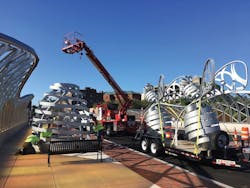A Connecticut bridge project exemplifies improved pedestrian and bicycle connections and reverses years of blight and neglect
By: Ted DeSantos
Recently a film crew transformed a downtown city street in Hartford, Connecticut with fake snow, twinkle lights, and holiday decorations.
Attempting to recreate a true New England look for a Lifetime Channel movie, this particular location was chosen because it is the only street in Hartford that maintains its early 20th-century streetscape, complete with cobblestones, low-rise buildings, and storefronts.
While many of us get nostalgic for tradition around the holidays, I have dedicated my career to preserving great downtowns while recreating the public realm for a safe and traversable future. Infrastructure has to keep up with the evolution of cities and towns, as well as with the way it is used by their citizens. What was once a country of Main Streets—one street in every town that was home to the locally owned hardware store, butcher, and pharmacy—became a nation of shopping malls, behemoth developments bursting with food courts, big-box retailers, and multiplexes. Urban renewal brought many traffic lanes directly through the hearts of our downtowns, and the world became a place for cars. With the advent of e-commerce, these malls now sit mostly empty, and small businesses face even bigger challenges. Those wide streets we built are not great places for people to walk and live. The problems of land use, transportation, and commercial change have rippled through small towns, and mid-size cities are struggling to adapt to a new world economy. We know the problem when we see it, but what is the solution?
A known concept
Transit-oriented development (TOD) is not a new concept. The city of Hartford, for example, had a terrific streetcar system up until the mid-1930s, featuring 20 radial connections to the region. There were more than 600 miles of streetcar track in Connecticut at that time, and our urban and suburban centers were built around public transit commuters and manufacturing jobs taking advantage of our talented workforce and the network of water-powered mills. As a transportation engineer, I have been a participant in many a successful contemporary TOD project. At present, I am working with the township of Windsor Locks, which is home to the region’s largest commercial airport. More than 6 million people use this airport yearly, but the town has been seeing very little economic return on that influx of people. Windsor Locks is also home to an Amtrak train station, which was relocated from downtown to be near the interstate highway—nowhere near the airport or the downtown area.
Building on the idea of restoring the train station to its historic downtown location, a TOD study was performed, which included analysis of land use and transportation opportunities and challenges to implement a renewed vision for the downtown area. The study, which provided a step-by-step approach to downtown growth, detailed a strategic roadmap for enhanced regional multimodal connectivity, identified property redevelopment opportunities consistent with TOD and smart-growth principles, provided form-based coding for the downtown area, and prescribed a new plan for downtown infrastructure. Development of the plan involved a consensus-building process engaging local residents and state and civic leaders. Since the completion of this plan, implementation has seen a dramatic increase in brick-and-mortar TOD activity in the properties surrounding the station. Beacon Communities has made a bold investment in the restoration of the abandoned Montgomery Mill into a 160-unit apartment complex, and other mixed-use development is contemplated across from the station, bolstered by the township’s adoption of Connecticut’s first Tax Incremental Financing (TIF) district, which incentivizes private investment. The Connecticut DOT (CTDOT) is completing design of the new station site, and my team is designing complete streets and streetscapes in the downtown to complement the public transit aspect.
It works, why’s there not more of it?
If TOD is such a simple and beneficial option, why isn’t it being implemented in every city, town, and borough across the country? The answer is, as it usually is, lack of funding. It is a vicious cycle. The cost of new construction and renovation of buildings is more than the building can generate in rent for the property owner under current market conditions. Funds for infrastructure improvements are available when they are allotted from tax dollars. But excess tax dollars only exist in areas with strong property tax revenue. To drive revenue, you have to create increasing land value. But to increase land value, towns need revenue. While grant funding and bonds are available, creative solutions also exist. Funds are almost always set aside for maintenance and reactive projects: bridge repair, road repaving, or lane re-striping. What can be considered the most successful projects are those that take these reactive projects and weave in proactive solutions to create land value, while remaking the public realm infrastructure for people—not just vehicles.
Here’s a couple of cases in point:
Pawtucket, Rhode Island is implementing green stormwater infrastructure (GSI) solutions in a TOD district. The city has recognized the potential for TOD to stimulate economic development opportunities in what is planned to become a live, work, and play neighborhood. The area required stormwater solutions, and rather than opting for traditional gray infrastructure, GSI provides a nature-based solution that will provide green space in the neighborhood while managing stormwater. These green elements (e.g., trees and planters) will improve the quality of life for neighborhood residents and businesses, which will help facilitate redevelopment. In particular, Pine Street will serve as a gateway to the Pawtucket-Central Falls commuter rail station. The design includes introducing stormwater runoff through curb inlets and street-side retention planters. Planters include trees and ornamental grasses. These natural systems are more cost-effective than traditional systems, and they bring green spaces to areas that are primarily gray.
In another example, Manchester, New Hampshire has experienced significant success in revitalizing its city center area over the past 30 years. Vacant mills and commercial buildings comprised the area formerly occupied by the Amoskeag Manufacturing Company, now known as the Millyard, which is immediately adjacent to a beautiful downtown. Thanks to the vision of entrepreneurs, investors, and city leaders, these areas are now filled with thriving businesses, innovative startups, and successful educational institutions. Areas that had been underutilized industrial sites are now popular residential complexes, stadiums, and restaurants.
For all of the success in the Millyard area and the adjacent downtown, expanding development across the southern Millyard border of Granite Street now faces significant challenges. Continued growth in a dense district requires the need for better transportation options, including connectivity and congestion mitigation for the increased numbers of users. Fuss & O’Neill worked closely with Mayor Joyce Craig and the city public works department to conduct a broad community engagement charrette and imagine the future of South Millyard.
Following the charrette, Fuss & O’Neill expedited work on concept design and cost estimate, and drafted an application for federal BUILD grant funding from the U.S. DOT. The Reconnecting Manchester for 21st Century Innovation Project includes roadway, bridge, bicycle, and pedestrian infrastructure improvements at a total cost of $24.8 million, including $4.9 million in local match. The project will create the enhanced connectivity and congestion mitigation to enable an estimated $2.4 billion of private investment within the 125-acre project area, including redevelopment and new construction development opportunities.
Making it work
Looking for proactive solutions in reactive projects can sometimes take creativity, but it also requires commitment to a community’s future. Five years ago, the city of New Britain, Connecticut experienced a windfall investment by the state in a new CTfastrak station and high-end bus rapid transit service connecting to the region. The CTfastrak station sat downtown on a state-owned bridge that allowed the city-owned Main Street to cross over Route 72, which itself was one of those urban renewal highways that devastated a downtown, tearing down homes and businesses in the name of “progress.” The Main Street bridge separated two areas: the vibrant Little Poland neighborhood and downtown New Britain. Both of these areas had business and residents, as well as dynamic cultural draws, but they were separated by the high-speed, five-lane overpass of Route 72, which was walkable or bikeable. The city recognized that connecting these two neighborhoods with an iconic bridge would create the conditions for TOD to happen, a structure that spoke to the history of the city while embracing a bright future and remaining uniquely New Britain.
As design got underway, funding was an immediate question: $1.6 million was secured from a Federal Transit Administration Bus Livability grant. CTDOT not only approved the installation of artwork and innovative pedestrian screening, but also put down more than $2 million in funding. This spirit of investment would be a running theme throughout this project. The final design of the bridge, which pays homage to the city’s motto—“Industry fills the hive and enjoys the honey”—with honeycomb parapets, gigantic bee sculptures anchoring each corner, and a hive sculpture in the center, was the result of multiple public workshops and collaboration among design team members (Svigals + Partners; Pirie Associates; Richter & Cegan Inc.), city officials (Mayor Erin Stewart, Public Works Director Mark Moriarty, P.E., and City Engineer Rob Trottier, P.E.), and other project stakeholders on the Project Advisory Committee. Main Street was reduced from five lanes to three, and the extra space was given to bikes and pedestrians. Sidewalk widths were increased, bike lanes were added, and the honeycomb screenings were lit by programmable LED lighting for a dramatic nighttime effect.
New Britain’s investment in complete streets, art, and architecture has already begun paying dividends. The Connecticut Main Street Center (www.ctmainstreet.org) advocated for and contributed early financing toward a TOD at 99 West Main Street, within walking distance of CTfastrak. Presently under construction is Columbus Commons, a $58 million mixed-use TOD with 160 new apartment units, only a short walk from the Beehive Bridge. Investment in public transit and downtown infrastructure is a model for community prosperity that has stood the test of time. It is great to see cities and towns innovating and building projects of lasting value. Planning for mobility is planning for community; the two are inextricably linked, and success is all too easy to achieve.
About The Author: DeSantos is senior vice president of community development for Fuss & O’Neill.








